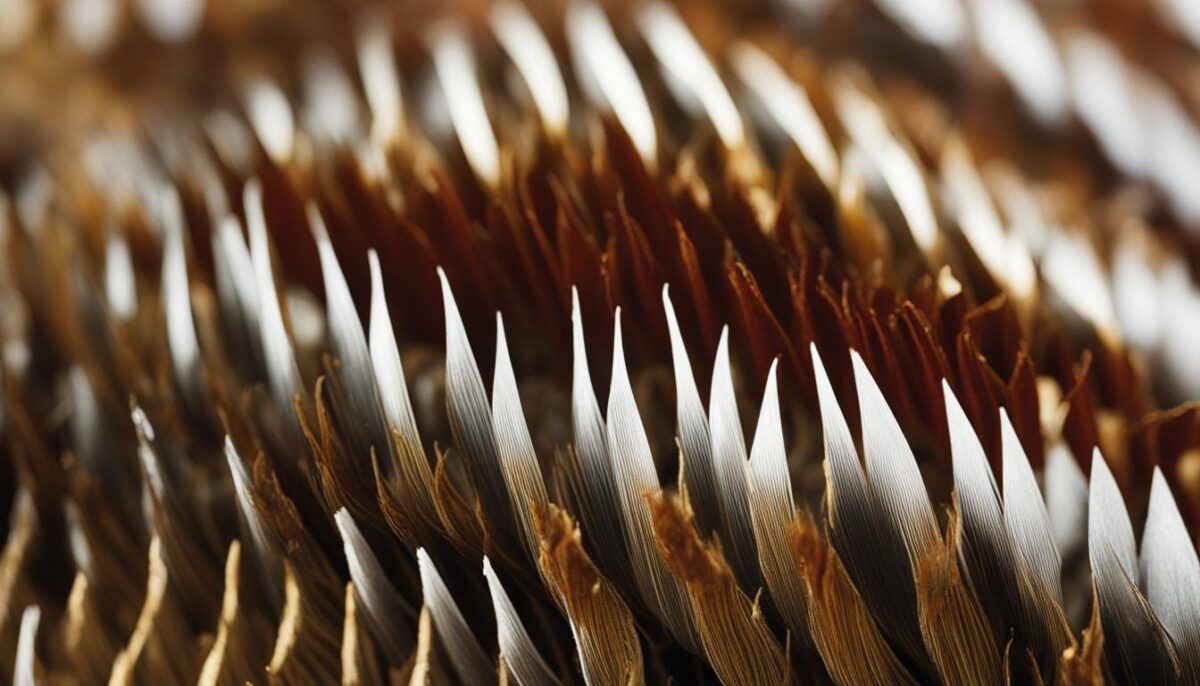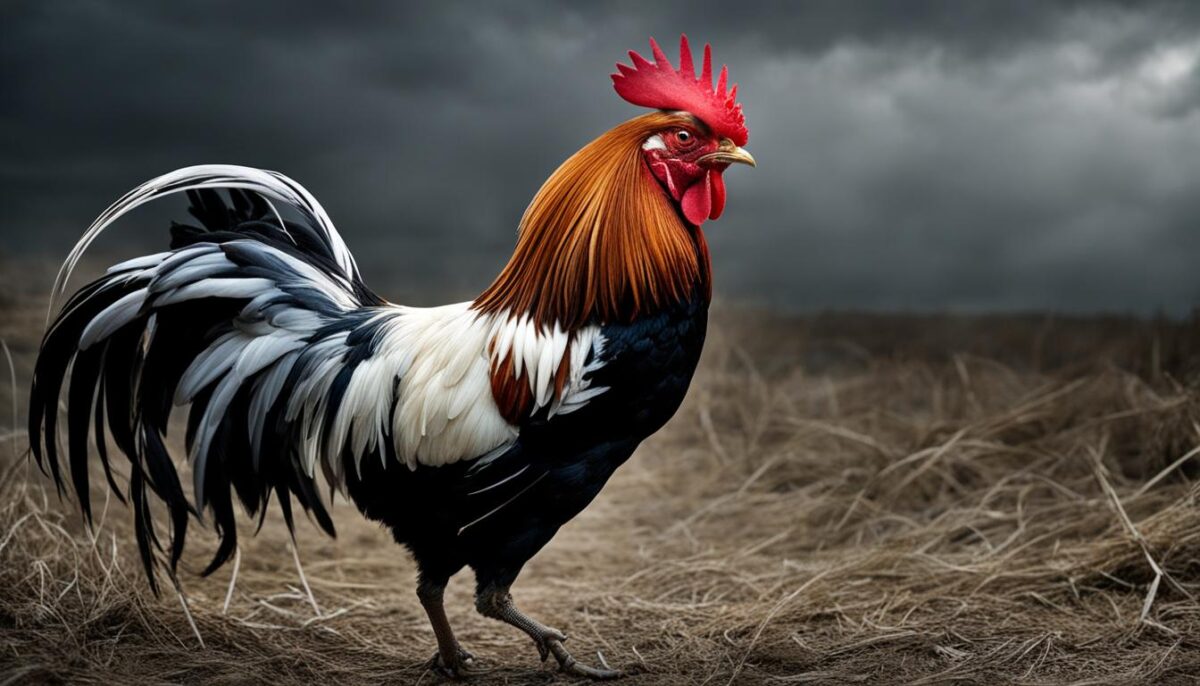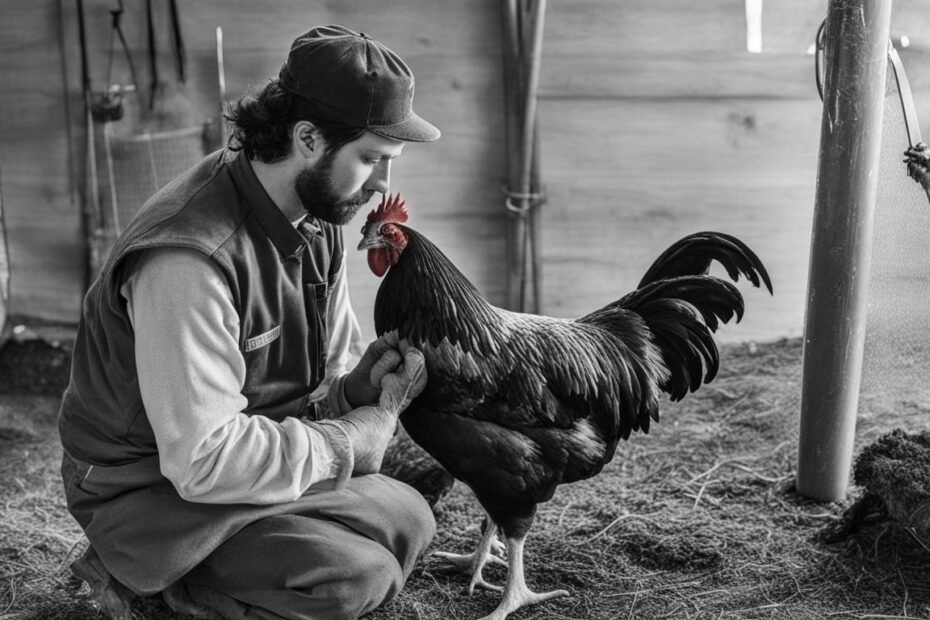Are you a chicken keeper looking to manage your rooster’s aggression and behavior? Castrating a rooster, also known as caponization, may be a solution worth considering. In this comprehensive guide, we will provide you with valuable insights into the castration methods for roosters, highlighting the benefits, potential risks, and important factors to consider before proceeding.
Key Takeaways:
- Castrating a rooster involves removing the testicles to reduce aggression and enhance poultry management.
- It is recommended to seek skilled personnel for this procedure.
- Consider the irreversible nature of castration and the potential for complications.
- The cost of castration ranges from $100 to $200.
- Caponization can improve meat quality and increase a rooster’s lifespan.
Can You Really Neuter a Rooster?
Neutering a rooster, also known as caponization, is a procedure that involves removing the testicles to modify the behavior and reduce aggression. While it may seem like a straightforward process, neutering a rooster is more complicated than neutering other male animals. The testicles of a rooster are internal, making the procedure riskier and requiring the expertise of skilled professionals.
The ideal age for neutering a rooster is typically around 6 weeks to 3 months old. Performing the procedure after sexual maturity may have less impact or even harmful effects on the bird. Once neutered, the rooster, now called a capon, retains its physical characteristics such as size, comb, and wattles. Neutering is a permanent procedure and cannot be reversed, so it is important to carefully consider the potential benefits and risks.
The Importance of Professional Expertise
Neutering a rooster requires skilled personnel due to the complexity and risks involved. It is not recommended to attempt this procedure yourself, as it could lead to complications and harm the bird.
Neutering a rooster can have several benefits, such as reducing aggression and improving meat quality. Neutered roosters are often easier to handle and live with, as their aggressive tendencies are diminished. Additionally, the meat of neutered roosters is known to be more tender and flavorful compared to intact roosters, making them desirable for consumption.
However, it is important to note that neutering a rooster comes with potential disadvantages and risks. The procedure itself can be costly if performed by a professional, and there is always a risk of complications during or after the surgery. It is crucial to consult with experts and weigh the potential benefits and risks before making a decision.
Neutering a rooster, when done by professionals, can be an effective way to modify behavior and create a more manageable flock. However, it is not the only option for dealing with aggression in roosters. Taming aggressive roosters through training and behavior modification techniques can also be effective in managing their behavior. It is important to assess the specific situation and consider the best approach for maintaining a peaceful and harmonious environment for both roosters and other chickens.
The Procedure and Physical Changes
Performing castration on a rooster involves a simple yet delicate procedure that should be carried out by skilled professionals. The process begins by restraining the bird and making a small incision near the ribs to expose and remove the testicles. This operation takes less than 30 minutes when performed by an experienced practitioner. It is important to note that castration is an irreversible procedure and should not be attempted without proper knowledge and training.
After castration, a neutered rooster may experience certain physical changes. One notable difference is the reduction in size of the comb and wattles, which are the fleshy protuberances on top of the head and beneath the beak, respectively. Additionally, the feathers of a neutered rooster may appear less vibrant compared to those of an intact rooster. These physical changes are often desired by chicken keepers as they contribute to creating a more manageable and peaceful flock.

The Physical Changes in a Neutered Rooster:
| Physical Attribute | Changes |
|---|---|
| Comb and Wattles | Smaller in size |
| Feathers | Less vibrant |
Neutering a rooster can be an effective way to manage aggression and improve flock dynamics. However, it is important to weigh the benefits against the irreversible nature of the procedure and potential complications.
Neutered roosters often exhibit a decrease in aggression and a more docile temperament. They are generally less aggressive towards other chickens and humans, making them easier to handle and integrate into a flock. These behavioral changes can be attributed to the reduction in testosterone levels, which typically drives aggressive behavior in roosters. Overall, castrating a rooster can contribute to a more harmonious and peaceful environment for both the chickens and their keepers.
Benefits and Disadvantages of Neutering
Neutering a rooster, also known as castration, offers several benefits for chicken keepers. One of the main advantages is a reduction in aggression. By removing the testicles, the levels of testosterone in the rooster’s body decrease, resulting in a calmer and less territorial bird. This makes the rooster easier to handle and live with, especially in backyard settings where space is limited.
Another benefit of castrating a rooster is the improvement in meat quality. Neutered roosters, known as capons, tend to have meat that is more tender and flavorful compared to intact roosters. This is because the absence of testosterone-driven muscle development results in a plumper physique, making them more suitable for meat production. The enhanced taste and texture of capon meat can be a desirable outcome for those raising chickens for consumption.
However, it is important to consider the potential disadvantages and risks of rooster castration. One significant drawback is the irreversible nature of the procedure. Once a rooster is castrated, its fertility is permanently eliminated, which means it can no longer reproduce naturally. This may be a concern for chicken keepers who are interested in breeding or maintaining a self-sustaining flock. Additionally, like any surgical procedure, there is a risk of complications during or after the surgery, which can lead to pain or even death for the bird. It is crucial to consult with professionals and weigh the benefits and risks before deciding to castrate a rooster.
Table: Benefits and Risks of Rooster Castration
| Benefits of Rooster Castration | Risks of Rooster Castration |
|---|---|
| Reduces aggression | Potential for complications during or after surgery |
| Improves meat quality | Irreversible fertility loss |
| Increases lifespan | Costly procedure if performed by a professional |
Considering the benefits and disadvantages, chicken keepers should carefully evaluate their specific situation and goals before deciding whether to castrate a rooster. It is essential to prioritize the well-being of the bird, consult with professionals, and explore alternative methods of managing aggression, if appropriate. Whether through castration or other behavior modification techniques, the key is to create a safe and harmonious environment for both the roosters and the rest of the flock.
Neutering vs. Taming Aggressive Roosters
When it comes to managing aggression in roosters, there are different approaches to consider. Neutering, also known as rooster castration, is one option that can help modify aggressive behavior by reducing testosterone levels. However, it is important to note that neutering should only be performed by skilled professionals due to the complexity of the procedure and potential risks involved.
Another approach to managing aggressive roosters is through taming and behavior modification techniques. This involves training the rooster to exhibit alternative behaviors and establishing boundaries. While this method may require time, patience, and consistency, it can be effective in creating a more manageable and peaceful flock.
It is crucial to assess the specific situation and consider the best approach for dealing with aggressive roosters. Neutering addresses the root cause of aggression by reducing testosterone levels, while taming focuses on teaching alternative behaviors. Both methods have their advantages and disadvantages, and the best approach may depend on factors such as the rooster’s age, temperament, and the desired outcome. Consulting with professionals and considering the individual circumstances will help determine the most suitable course of action.
“Neutering a rooster is one way to modify aggressive behavior, but it is not the only option.”
Taming Aggressive Roosters: Tips and Techniques
- Establish a routine: Consistency is key when training roosters. Establish a regular feeding and handling routine to help them become familiar and comfortable with human interaction.
- Positive reinforcement: Reward desired behaviors, such as calm and non-aggressive actions, with treats or praise. This will encourage the rooster to repeat the behavior.
- Provide distractions: Offering toys or objects for the rooster to peck at and explore can redirect their energy and prevent aggressive behaviors.
- Use deterrents: Certain devices, such as spray bottles or noise-making tools, can be used to deter aggressive behavior. However, it is important to use them sparingly and not to harm the rooster.
- Separation and socialization: If an individual rooster remains extremely aggressive, it may be necessary to provide separate housing or introduce them to a different flock to reduce conflicts.
By employing these techniques and creating a calm and structured environment, aggressive roosters can be managed effectively without resorting to castration. However, it is essential to understand that behavior modification takes time and consistency, and complete elimination of aggression may not always be possible.
| Neutering | Taming |
|---|---|
| Reduces testosterone levels | Teaches alternative behaviors |
| Irreversible procedure | Requires time and consistency |
| Risks involved | No risks associated with the procedure |
| May affect rooster’s physical characteristics | Physical characteristics remain unchanged |
Understanding Aggressive Rooster Behavior
Aggression in roosters can be attributed to various factors, including breed characteristics and individual temperament. These birds are instinctually driven to protect their flock and assert dominance through mating. As a result, they may display aggressive behaviors such as flogging, spurring, chasing, or pecking when they feel threatened or need to establish hierarchy within the group. Understanding the underlying causes of rooster aggression is crucial in effectively managing and addressing their behavior.
The primary cause of rooster aggression is their natural instinct to protect the flock and maintain their genetic lineage through mating. Some roosters may inherently possess more aggressive tendencies than others due to their breed characteristics. However, environmental factors such as overcrowding, lack of resources, or perceived threats can also contribute to heightened aggression in roosters. It is essential to assess the specific situation and identify any potential triggers or underlying issues that may be fueling aggressive behavior.
“Aggressive behavior in roosters can be compared to a primal instinct deeply ingrained in their DNA. Understanding the nature of these birds and their innate drive for self-preservation is key to effectively managing their behavior.” – Poultry Behavior Expert
By managing and modifying the environment, it is possible to mitigate rooster aggression. Providing sufficient space, ensuring an adequate supply of food and water, and creating designated areas for roosters to establish territories can help alleviate aggression. Additionally, implementing safety measures such as proper handling techniques, wearing protective clothing, and avoiding sudden movements can reduce the risk of confrontations with aggressive roosters.
| Common Causes of Rooster Aggression | Management Strategies |
|---|---|
| Protecting the flock | Ensure sufficient space and resources |
| Establishing dominance | Designate separate territories for roosters |
| Mating instinct | Consider introducing additional hens or using chicken saddles |
| Environmental stressors | Address overcrowding and provide a stimulating environment |
| Genetic predisposition | Select breeds known for docile temperament |
Understanding the behavior of aggressive roosters and implementing effective management strategies can contribute to a more harmonious and peaceful flock. By addressing the underlying causes and providing a conducive environment, chicken keepers can foster a healthier and safer living space for both roosters and hens.

Managing and Protecting Against Rooster Aggression
When it comes to taming and managing aggressive roosters, taking appropriate measures is essential for the safety and well-being of both the birds and the chicken keepers. Here are some strategies and precautions to consider:
Sufficient Space and Resources
Providing ample space for roosters and the flock can help minimize aggression. A crowded environment can lead to territorial disputes, which can trigger aggressive behavior. Ensure that the coop and run are spacious enough to accommodate the roosters comfortably. Additionally, make sure to provide an adequate supply of food, water, and other resources to avoid competition and reduce stress.
Separation and Chicken Saddles
If mating behavior becomes problematic or if certain roosters are particularly aggressive, consider separating them from the rest of the flock. This can prevent fights and injuries. Another option is to use chicken saddles, which are protective coverings that can be placed over the hens’ backs. These saddles can help prevent injuries from aggressive roosters during mating.
Caution and Protection
Approaching and handling aggressive roosters requires caution. Wear protective clothing, such as long sleeves, gloves, and sturdy footwear, to minimize the risk of scratches or bites. Avoid sudden movements or loud noises that may startle the roosters and trigger aggressive behavior. It’s also important to refrain from any aggressive or violent behavior towards the roosters, as this can escalate aggression and make them more dangerous.
Training and Behavior Modification
While complete behavior change may not always be possible, training and behavior modification techniques can help manage aggression in roosters. Consider working with a professional or experienced trainer who can guide you in implementing positive reinforcement techniques and establishing boundaries. Patience, consistency, and reward-based training methods can go a long way in taming and minimizing aggression in roosters.
By implementing these strategies and precautions, chicken keepers can successfully manage and protect against rooster aggression, creating a safer and more peaceful environment for both the roosters and other flock members.
Signs of Aggression and Safety Precautions
Recognizing signs of aggression in roosters is crucial for personal safety. It’s important to be aware of the behaviors that indicate an imminent attack. Some common signs of rooster aggression include:
- Running towards and staring intensely
- Dancing or moving aggressively around you
- Lowering the head while maintaining eye contact
- Attempting to peck or spur
When dealing with aggressive roosters, it’s important to take safety precautions to minimize the risk of harm. Here are some safety measures to consider:
- Wear protective clothing, such as gloves and boots, to guard against pecks and spurs.
- Avoid sudden movements or actions that may provoke the rooster.
- Maintain awareness of the rooster’s behavior and body language to anticipate potential attacks.
- Separate or isolate the aggressive rooster during certain activities, especially when children or pets are present.
Taking these safety precautions can help prevent injuries and ensure a safer environment when dealing with aggressive roosters.

Table: Safety Precautions
| Safety Precautions |
|---|
| Wear protective clothing |
| Avoid sudden movements |
| Maintain awareness of behavior |
| Separate or isolate rooster during activities |
Conclusion
In conclusion, castrating a rooster, also known as neutering, can be a viable option for reducing aggression and modifying behavior. However, it is crucial to approach this decision with careful consideration. Consulting professionals and understanding the benefits and risks are essential steps before proceeding with the procedure.
Alternatively, taming and managing aggressive roosters through training and appropriate flock management techniques can also be effective in promoting a peaceful environment. By understanding the instincts and behavior of roosters, providing adequate space and resources, and implementing proper safety precautions, successful rooster management can be achieved.
Whether you choose to castrate a rooster or employ other management techniques, it is important to prioritize the well-being and safety of both the rooster and those interacting with it. By following our castrate a rooster guide and implementing effective rooster management tips, you can create a harmonious and enjoyable environment for both chickens and their caretakers.
FAQ
Can I castrate a rooster myself?
Castrating a rooster should be done by skilled personnel. It is not recommended to perform the procedure yourself.
At what age should a rooster be neutered?
Roosters are typically neutered around 6 weeks to 3 months old.
What physical changes can I expect in a neutered rooster?
Neutered roosters may have smaller combs and wattles, less vibrant feathers, and a more docile demeanor.
What are the benefits of neutering a rooster?
Neutering reduces aggression, improves meat quality, and can increase the bird’s lifespan.
What are the potential disadvantages of neutering a rooster?
Neutering is an irreversible process and can have complications. It can also be a costly procedure.
Can aggressive roosters be tamed without neutering?
Yes, aggressive roosters can be tamed through training and behavior modification techniques.
What are the signs of aggression in roosters?
Signs of aggression in roosters include running towards and staring, aggressive movements, lowering the head while maintaining eye contact, and attempts to peck or spur.
How can I manage and protect against rooster aggression?
Providing sufficient space, separating roosters when necessary, and implementing safety precautions can help manage and protect against rooster aggression.
What safety precautions should I take when dealing with aggressive roosters?
Wear protective clothing, avoid sudden movements, and be aware of the rooster’s actions. Separating or isolating the rooster during certain activities can also minimize the risk of aggression.


